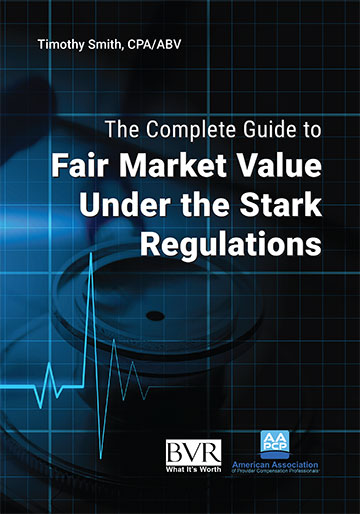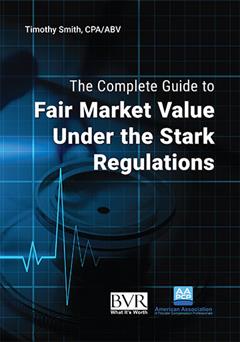The Complete Guide to Fair Market Value Under the Stark Regulations
August 2022 PDF, Softcover
Timothy Smith
Business Valuation Resources, LLC
Published in collaboration with American Association of Provider Compensation Professionals (AAPCP), this timely new Guide by healthcare valuation expert Timothy Smith delivers a critical and in-depth assessment of the new definitions of fair market value (FMV) under the recently updated regulations for the federal physician self-referral law – the Stark law. The updated regulations make critical changes in how accepted valuation principles and practices are used to determine Stark FMV.
One unique feature of this new Guide is that it provides the actual text of the public comments the Center for Medicare & Medicaid Services (CMS) responded to in the preamble commentary to the final Stark regulations. The Guide makes it easy for readers to understand the full extent of all issues brought to CMS in response to the agency’s proposed regulations on FMV. The Guide also presents CMS’ summary of these public comments and its responses to them.
There is an entire section devoted to the examination all of the CMS commentary on various topics and issues, along with insightful analysis and discussion of its implications for healthcare valuation practice.
This publication is a collaboration with the American Association of Provider Compensation Professionals (AAPCP)
PART I. INTRODUCTION
Editor’s Introduction: How to Use This Guide.- Introduction to This Guide.
- The Role of the Public Comments in Developing the New Stark FMV.
- Approaching the New Stark FMV Thematically and Holistically.
- An Educational and Desk Reference Resource.
- Introduction.
- CMS’ History of the Stark Regulations
- CMS’ Update to the Stark Regulations (2020).
- The Historical Development of the Definitions of FMV and GMV.
PART II. PUBLIC COMMENTS AND CMS RESPONSES
Chapter 1. Comments on the Definition of GMV: Buyers and Sellers Without Business Relationships- Background to the Public Comments: CMS’ Proposed Regulations
- Public Comments to CMS
- CMS Response to the Comments.
- Introduction.
- Public Comments to CMS.
- CMS’ Response to the Comments.
- CMS’ Commentary on Losses and Commercial Reasonableness.
- Introduction.
- Public Comments to CMS.
- CMS’ Response to the Comments.
- Introduction.
- Public Comments to CMS.
- CMS’ Response to the Comments.
- Introduction.
- Public Comments to CMS.
- CMS’ Response to the Comments.
- Introduction.
- Public Comments to CMS.
- CMS’ Response to the Comments.
PART III. CMS REVISIONS AND THE PUBLIC COMMENTS:
THE HIDDEN STORY
Chapter 7. The Retracted Definition of FMV: We Don’t Like ‘Likes’- Introduction.
- CMS’ Retracted Definition of FMV.
- Public Comments on the Definition of FMV and ‘Likes’.
- Introduction.
- CMS Commentary on FMV as a Hypothetical Transaction Value.
- Public Comments on FMV as a Hypothetical Value.
- Introduction.
- The Economics of the Subject Transaction.
- Buyer Neutrality.
White Paper.
I. Introduction.
II. Fair Market Value under the Current Regulatory Definition.
III. Valuation Practice under Current Stark Preamble Commentary.
IV. Conclusion.
PART IV. TOPICAL DISCUSSIONS
Chapter 11. The Fair Market Value of the Subject Transaction.- Introduction.
- ‘Of the Subject Transaction’ in the Stark Regulations.
- Analysis and Evaluation of the Regulatory Text and Commentary.
- Application and Implications for Valuation Practice.
- Introduction.
- How a Standard of Value Functions in Valuation.
- Identifying the Elements in the Stark Definition of FMV.
- Analyzing the Stark Definition of FMV as a Standard of Value.
- Implications and Applications for Valuation Practice.
- Introduction.
- CMS’ Discussion of a ‘Commercially Reasonable’ Valuation Method.
- Analysis and Evaluation of the Commercially Reasonable Method Standard.
- Implications and Applications for Valuation Practice.
- Introduction.
- The Doctrine of Precluded Reliance.
- Analysis of the Precluded Reliance Doctrine.
- Implication and Applications for Valuation Practice.
- Introduction.
- Historical Background: ‘CMS Favors the Market Approach’.
- New Stark Regulations: CMS Policy Is FMV Methodological Neutrality.
- Analysis and Evaluation of CMS’ Commentary.
- Introduction.
- CMS Commentary on Survey Data Usage.
- Analysis and Evaluation of CMS’ Commentary.
- Implications and Applications for Valuation Practice.
- Appendix. CMS on ‘Survey Says’ in the Halifax Case.
- Introduction.
- Using Survey Data Consistent With the Precluded Reliance Doctrine.
- Meeting the Stark Criteria for Valuation Methods.
- Addressing Practice Losses.
- Conclusion.
- Introduction.
- The New Status of Valuation Concepts and Principles for Stark FMV.
- Analysis and Evaluation of CMS’ Commentary.
- Implications and Applications for Valuation Practice.
- Introduction.
- CMS Commentary on the Economics of the Subject Transaction.
- Analysis and Evaluation of CMS’ Commentary.
- Implications and Applications for Valuation Practice.
- Introduction.
- CMS’ Commentary on Buyer Neutrality.
- Analysis and Evaluation of CMS’ Commentary.
- Implications and Applications for Valuation Practice.
- Evaluating the Willing Buyer in Stark and Traditional FMV.
- Introduction.
- CMS Commentary on Losses as a FMV Issue.
- CMS Commentary on Losses as a CR Issue.
- Analysis and Evaluation of CMS’ Commentary.
- Implications and Applications for Valuation Practice.
- Introduction.
- CMS’ Background for the Compensation Examples.
- The Orthopedic Surgeon.
- The Family Physician.
- The Cardiothoracic Surgeon.
- Key Takeaways From the Compensation Examples.
- Introduction.
- The Valuation Dates in the New Stark Regulations.
- Analysis and Evaluation of the New Valuation Dates for FMV.
- Implications and Applications for Valuation Practice.
- Introduction.
- Previous Definition of Fair Market Value (42 U.S.C. § 1395nn).
- Current, Three-Part Definition of Fair Market Value (42 C.F.R. § 411.354).
- Current Definition of General Market Value (42 C.F.R. § 411.354).
- Introduction.
- Subject Transaction.
- Buyer-Neutral.
- Conclusion.
PART V. ARRANGEMENTS NOT SUBJECT TO FMV
Chapter 26. An Overview of Compensation Plans That Do Not Require FMV Compliance- In-Office Ancillary Services Exception (IOASE).
- Value-Based Payment Exceptions.
- Introduction.
- The VBE Final Rule.
- VBE Compliance.
- Conclusion.

